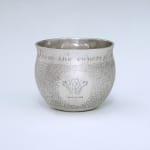



John Cruttall (probably)
A Charles II Antique English Tumbler Cup, 1683
Height: 3 1/4"
Weight: 6 oz. 16 dwt.
Weight: 6 oz. 16 dwt.
London
H0638
Sold
Further images
This is among the largest tumbler cups known. The rim is inscribed 'The Gift from the owners of The Reliant'. Engraved on front with the crest of Enys. We are...
This is among the largest tumbler cups known. The rim is inscribed "The Gift from the owners of The Reliant". Engraved on front with the crest of Enys.
We are grateful to Ted Clive for the information that the crest is of the Enys family of Cornwall, and the recipient was probably Valentine Enys, 1653-1719. Valentine was a merchant with regular business between Cornwall and the Canaries.
The maker's mark "IC mullet below" is listed in Jackson, p. 139.David Mitchell in "Silversmiths in Elizabethan and Stuart London" (p. 350) identifies the maker as probably John Cruttall, a very successful silversmith who bound eighteen apprentices.
We are grateful to Ted Clive for the information that the crest is of the Enys family of Cornwall, and the recipient was probably Valentine Enys, 1653-1719. Valentine was a merchant with regular business between Cornwall and the Canaries.
The maker's mark "IC mullet below" is listed in Jackson, p. 139.David Mitchell in "Silversmiths in Elizabethan and Stuart London" (p. 350) identifies the maker as probably John Cruttall, a very successful silversmith who bound eighteen apprentices.



